
by Mike Quigley | Feb 17, 2017 | Blog
When attic mold is involved in the sale of a home, I am frequently asked, “what is the one thing we need to do to correct the attic mold problem”? Unfortunately, it is usually never one thing causing the mold, but instead is a combination of multiple contributors.
Usually, excess moisture enters the attic through the ceiling, utility chases, electrical fixtures, missing or improperly installed insulation, and the attic entry way. This warm moist air is condensing on the colder roof structures during the fall, winter, and spring months. Without proper ventilation, excess moisture cannot be carried away.
Mold in the attic is typically caused by the intrusion of warm moist air due to elevated humidity in the living space from:
1. Cooking and showers;
2. Gas appliances;
3. Excess humidity from clothes dryers;
4. Fish tanks and plants;
5. Wet basements including open sump pump pits, dirt
basements, and foundation cracks;
6. Efflorescence caused by water infiltration into the basement
usually due to improper yard grading;
7. Inadequate ventilation in the attic due to:
A) Blocked, missing, or undersized soffit vents;
B) Blocked, missing, or undersized ridge vent; and,
C) Blocked, missing, or damaged soffit vent chutes.
8. Leaking ductwork due to improperly installed HVAC systems;
9. The bathroom fan venting into the attic or soffit;
10.Excessive or improperly installed insulation including a
missing vapor barrier;
11. A missing attic staircase cover;
12. Open chasses around the plumbing, light fixtures, or
chimney;
13. A lack of solar drying (trees and shrubs);
14. Roofing, vent pipe flashing, and chimney flashing leaks;
15. Plumbing and heating system leaks; and,
16. Ice dams.
If you are a homeowner, ask yourself this question. Have I done anything to upset the balance of my home’s operating systems? Have you,
1. Upgraded the heating system?
2. Installed replacement windows?
3. Added insulation?
4. Added new siding?
5. Removed trees or shrubs?
If you have replaced something original to the home or from when you purchased the house, it may have impacted the way your home currently functions.

by Mike Quigley | Feb 17, 2017 | Blog
A client bought a house two years ago with no mold growth in the attic space. He installed replacement windows and added insulation to the attic and basement. The house was warmer but it also retained more water vapor. Since the client did not add ventilation to the attic space to remove the excess water vapor that was created when the house was tightened up, water droplets formed on the attic sheathing (plywood) and allowed the ever-present mold spores floating in the air to start growing. The client created his own mold problem.
I see this time and time again and it is almost always as a result of weatherization programs. The golden rule is, if you insulate, you must ventilate.
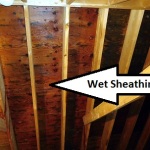

by Mike Quigley | Feb 17, 2017 | Blog
A real phone call from a client.
Client: “My wife won’t sleep with me!”
Me: “I’m sorry, what was your question”
Client: “My wife says she cannot breathe in the bedroom, so she will not sleep with me. I need you to come to my house and determine if there is a mold problem.”
Arriving to the rescue, I discovered that plastic had been taped over all of the upstairs bedroom windows, effectively sealing the room off from any fresh air supply. When I was young, everyone knew enough not to put a plastic bag over your head because you would suffocate. These days, common sense seems to fly right out the window.
Me: “Take the plastic off the windows and open them up for some fresh air.”
Client: “I’m trying to reduce my heating bill.”
Me:” At some point you have to determine if the course of action you are taking is logical. It’s great if you can heat your energy efficient and tightly sealed home using only a match. It is not so great if the air quality in your home is so poor that everyone in the house becomes sick.”
My recommendation for healthy air quality is this:
In the summer, use some type of air conditioning system to remove high levels of humidity from the house. Open the windows when the humidity is low to let some fresh air in. Make sure you open the windows in the fall to let trapped moisture out of your home. Trapped moisture will show up on the insides of your windows as warm moist air attaches to the cold glass.
A Helpful Hint: Lower the top sash on a double hung window and raise the bottom sash. This will let stale air out through the top and bring fresh air in through the bottom.
In the winter the mold spores outside are usually covered with a layer of snow. This will be your freshest, cleanest air. Every once in a while, during the winter months, open the windows and let some fresh air in. Your wife will thank you for it.

by Mike Quigley | Oct 2, 2016 | Blog
When your home was new, all the systems were in balance. We will call each original system of the home “X”. All changes will be called “Y”. The heating system, windows, insulation, ventilation system, septic system, yard grading etc. all matched in “X”. Now we will see how a perfectly matched home is systematically destroyed by well intentioned homeowners.
This series is intended to help home owners understand how seemingly small changes can affect the entire home.
Part One: House “X” was new and occupied by the original homeowners for 10 years. During the home inspection for the new buyers mold was discovered in the attic.
What changed? This house was built with a ventilated drip edge. This “hicks” style vent was designed to replace standard soffit vents. The caveat with this type of system is that you cannot use gutters with it.
The problem: The overhang on the house was so narrow that when water dripped off the edge of the roof, it splashed on the ground and back up on to the siding causing rot. That could have been avoided if the overhang was larger or the foundation was taller. Not aware of the no gutters with hicks vent rule, the homeowner attempting to solve the problem installed gutters on the house. Water was inevitably trapped in the gutter by debris, leaves, branches, and poor slope etc. As the sun baked the gutters, water evaporated and was drawn into the “vents” over the gutter. These are after all, intake vents which are half of a balanced attic ventilation system. The top half of this system is called the ridge vent.
The result: Excess water vapor in the attic activated floating dormant mold spores. The mold spores attached to the damp attic roof sheathing and started to form colonies. Mold remediation will have to be completed and the ventilation system will have to be changed to allow for the new gutter system.
The solution: Remove the “hicks” vents and install under the gutter soffit vents. Remember to match the intake with the exhaust for a balanced ventilation system. For example: If nine square inches per linear foot is installed at each soffit, then a total of eighteen inches per linear foot will need to be installed at the ridge.
In this scenario, the house was not designed to have gutters. Adding gutters changed “X” to “Y”. Adding the soffit vents and removing the over the gutter “hicks” vents brings the house back to “X”.
Hicks Vents Soffit vents
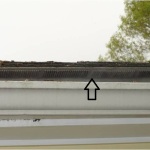
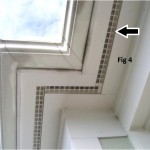

by Mike Quigley | Mar 21, 2016 | Blog
I was called to investigate a mold problem in an attic. The client had had a home inspection and the recommendation was to have the suspected microbial activity in the attic space further evaluated. I use that same wording on my reports. I asked of there were any pictures from the inspection he could forward to me . Usually the answer is no, the inspector did not take pictures. I take an average of 250 picture when I do an inspection. I digress. This inspector did take pictures and the client sent them to me.
The exterior inspection clearly showed a decent ridge vent and vented soffit panels. The interior showed soffit vent chutes. The inspector did the right thing in requesting a further evaluation. The inspector cannot disturb insulation while performing the home inspection. He couldn’t see that air sealing was not completed under the insulation. That’s not his job, it’s mine. Because there was no floor in the attic, the inspector could not enter to perform a complete inspection. Again, not his job, it’s mine. I brought some temporary flooring with me and crawled into the attic space. With the lights off I should have been able to see daylight at the soffit area. I thought this was another case of the siding contractor installing vents over solid wood soffits.
What I found was unusual. The siding contractor did cut the opening for the soffit. The soffit panels were covered with debris restricting air flow into the attic. We simply removed the soffit panels, vacuumed the panels and openings and re-installed the panels.
While measuring the attic for mold remediation, I noticed another problem. The insulation contractor used blown in cellulose insulation which is fine. However, he also managed to clog the ridge vent with insulation restricting exhaust at the ridge. We simply vacuumed that too. Proper ventilation was achieved with a vacuum cleaner. Air sealing was achieved with four cans of spray foam insulation. We remediated the attic , the deal went through and everyone was happy.
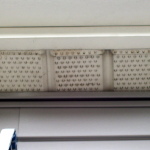
Perforated soffit panels
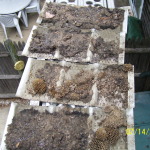
Clogged soffit panels

by Mike Quigley | Mar 21, 2016 | Blog
A typical call goes something like this. Good morning mold person. I had a home inspection and they found mold in my attic and recommended removing the mold and improving the attic ventilation system. I had a contractor in to install ridge venting now I need the mold removed.
In my head I am thinking ” mold removal before ventilation” not the other way around. I say it over and over again. The process of mold removal and the application of sealant can clog new ridge vents. I arrived at the house and this is what I found. The contractor drilled a 3/4″ hole through the ridge every 16″, misinterpreting the code of a 3/4″ minimum continuous cut. On top of that he installed a rolled ridge vent that was collapsed and performing no function.
The 3/4″ cut is too small for the amounts of insulation we have in our homes. My recommendation is to double that to 1 1/2″. Also, I have to remove the new ridge vent and caps, properly cut open the ridge and install a new performing ridge vent and caps.
In the image I have here you can see that the ridge cut should be equal to the vented opening of the ridge vent. The blue mesh filter should span side to side.
The other low bid, great deal contractor disappeared after the job and the homeowner had to pay the bill for the new work. I am not completely blaming the contractor. The homeowner is probably equally at fault. I bet there was at least one bid, probably the highest, who told the homeowner exactly what needed to be done.
Also remember that the general contractor, roofing contractor or home improvement contractor all are not ventilation or mold experts. Hire only qualified and insured (liability and workman’s comp insurance) certified mold remediation and ventilation contractors.
In order: Mold remediation first, ventilation second, air sealing third, insulation last.
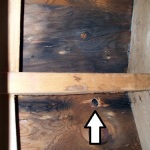
Improperly cut ridge
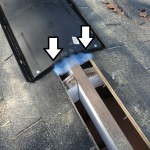
Properly cut ridge and vent







